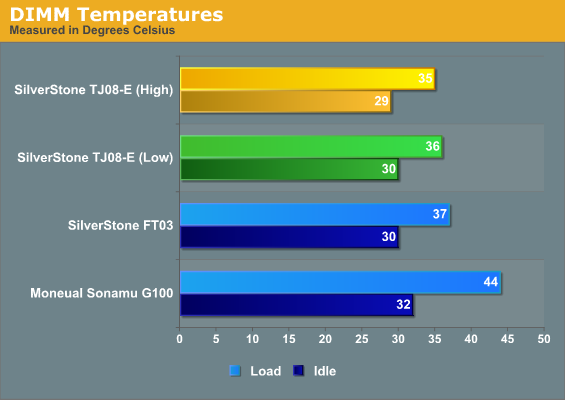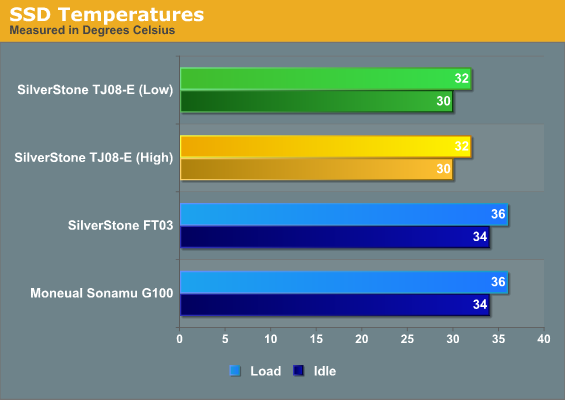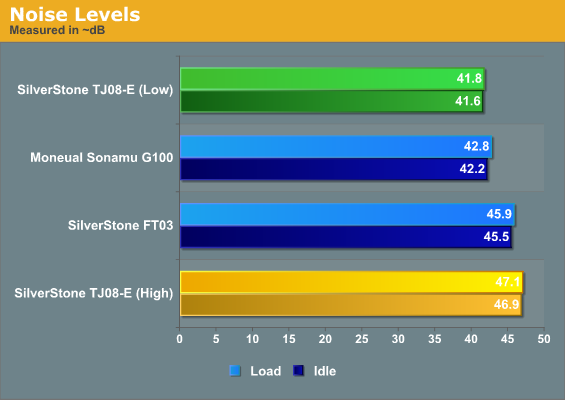SilverStone Temjin TJ08-E: Fat Case in a Little Coat
by Dustin Sklavos on August 4, 2011 1:50 AM EST- Posted in
- Cases/Cooling/PSUs
- Mini ITX
- SilverStone
- MicroATX
- Mini-Tower
Noise and Thermal Testing, IGP
SilverStone includes a small fan control switch recessed on the right side of the face of the Temjin TJ08-E that can be used to set the 180mm intake fan between high and low speeds, and so we tested with both settings. More and more I'm beginning to appreciate fan controls as just a way to make the case quieter rather than actually improving the airflow and temperatures, as you'll see in our results.




Right off the bat the TJ08-E puts in a hell of a showing. Such a good showing, in fact, that it even embarasses SilverStone's FT03. Switching between high and low fan speeds doesn't seem to do much to change thermal performance appreciably; however...

...the low fan speed certainly helps to reduce noise level, with the high speed being the loudest Mini-ITX/Micro-ATX case we've tested. On the other side of the chart, at the low fan speed, the Temjin is the quietest of the cases we've tested. 41dB may seem like a bit much, but our testing cooler has a tendency to run a bit loudly and unfortunately the Zotac board's fan controls are anemic at best. Still, the directed wind tunnel cooling design seems to pay off well when we're using the IGP in our Intel Core i3, but let's see how well the TJ08-E handles the substantially increased thermal load brought by our Zotac GeForce GTX 580.










47 Comments
View All Comments
superccs - Thursday, August 4, 2011 - link
mATX is a vastly more popular board size, one that I have been using for years.One thing I like to see is well thought out airflow, something that is very rare in most case designs.
JarredWalton - Thursday, August 4, 2011 - link
We decided on two test beds for our case reviews; for ATX-compatible and larger, we use a Sandy Bridge ATX motherboard and test with overclocking. For micro-ATX and ITX, we use a mini-ITX motherboard and, where possible, test with the GTX 580 installed. We figured two set configurations was better than three or four different options. The only thing mATX would potentially add is more performance and more heat, so by that token testing ITX in a uATX case is actually putting less strain on the cooling.JasonInofuentes - Thursday, August 4, 2011 - link
http://youtu.be/IolqkwNSmfAbobbozzo - Thursday, August 4, 2011 - link
FAKE youtube link above!GeorgeH - Thursday, August 4, 2011 - link
Using modular PSUs in small cases like this is often a bad idea and far from required. The problem with modular PSUs is that the modular bits tend to add significant length and stiffness that makes cable routing harder (often significantly.) Non-modular supplies might have an extra SATA cable or two to tuck away, but that's generally easy to do. Problems can come up with PSUs that are much too powerful and therefore come with tons of extra cables, but that's just operator error. :)Knifeshade - Thursday, August 4, 2011 - link
Wouldn't it be fairer to use stock coolers rather than custom CPU coolers? The CPU temp is rather impressive, at just 6-30 degrees Celsius above room temperature. But I can't help but think most of the kudos goes to the custom cooler rather than the cooling prowess of the case.Hrel - Thursday, August 4, 2011 - link
I like this case a lot, but how would one go about improving the acoustics? I mean, I could go out and buy sound dampening foam and put it in... but that stuff is really over-priced everywhere I've looked and that seems like kind of a pain.Dustin Sklavos - Friday, August 5, 2011 - link
The Zalman cooler we use for testing is honestly a bit loud and the Zotac board doesn't really have much in the way of fan control; just putting a quieter cooler (think the Cooler Master Hyper 212+) in would go a LONG way towards quieting down the Temjin.bobbozzo - Thursday, August 4, 2011 - link
This isn't the first article with this problem, but the white on yellow text in the graphs is near impossible to read on both my Dell LCD and my Samsung 2343BW.Also, you mention that the Antec Mini is bigger, but I would have liked to see more details & comparison.
Thanks!
MadMan007 - Friday, August 5, 2011 - link
This thing is begging to be used with a PICO-style PSU and just integrated graphics for those who don't need a discrete GPU.Or for those that do and aren't going to go with a high-end card and madly overclocked CPU, an SFX12V PSU like, oh, I don't know...Silverstone's very own ST45SF.